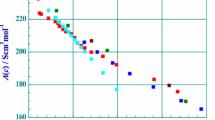Abstract
It is proposed that NH4OH be used as a standard for determining dissociation constants on a standard basis. Ultrasonic absorption and electrical conductance measurements as a function of pressure provide the basis for quantitative evaluation of all parameters except activity coefficients. It is shown how the weak ionization of NH4OH can be used to minimize uncertainty due to activity coefficients. Density data at atmospheric pressure confirm the\(\Delta \bar V^\circ\) values used to provide quantitative explanations of the acoustic and conductance data. Application of the differential sound absorption technique should extend the method dissociation constants of other classes of salts, in particular the 1–2, 2–2, and 3–2 sulfates.
Similar content being viewed by others
References
E. H. Carnevale and T. A. Litovitz,J. Acoust. Soc. Am. 30, 610 (1958).
K. Tamm,Proceedings of the International School of Physics “Enrico Fermi,” Course XXVII, Dispersion and Absorption of Sound by Molecular Processes D. Sette, ed. (Academic Press, New York, 1963), p. 175 and following.
F. H. Fisher,J. Solution Chem. 4, 237 (1975).
F. H. Fisher and A. P. Fox,J. Solution Chem. 6, 641 (1977).
G. Kurtze and K. Tamm,Acoustica 3, 33 (1953).
I. L. Jenkins and C. B. Monk,J. Am. Chem. Soc. 72, 2695 (1950).
F. H. Fisher and A. P. Fox,J. Solution Chem. 7, 561 (1978).
L. N. Liebermann,Phys. Rev. 76, 1520 (1949).
M. Eigen and K. Tamm,Z. Electrochem Ber. d. Bunsenges,66, 93 (1962).
M. Eigen,Z. Phys. Chem. N. F. 1, 176 (1954).
R. A. Robinson and R. H. Stokes,Electrolyte Solutions, 2nd edn. (Butterworths, 1959).
J. Stuehr and E. Yeager,Physical Acoustics, Principles and Methods, Vol. II, Part A, W. P. Mason, ed. (Academic Press, New York, 1965), p. 351 and following.
F. E. Fox and G. D. Rock,Phys. Rev. 70, 68 (1946).
J. M. M. Pinkerton,Nature 60, 128 (1947).
S. D. Hamann and W. Strauss,Trans. Faraday Soc. 51, 1684 (1955).
S. D. Hamann and S. C. Lim,Austr. J. Chem. 7, 329 (1954).
R. G. Bates and G. D. Pinching,J. Am. Chem. Soc. 72, 1393 (1950).
J. Buchanan and S. D. Hamann,Trans. Faraday Soc. 49, 1425 (1953).
C. Neuberger, C. C. Hsu, and F. H. Fisher,J. Solution Chem., to be submitted.
F. H. Fisher and A. P. Fox,J. Solution Chem. 4, 225 (1975).
C. W. Davies,Endeavour 4, 114 (1945);J. Chem. Soc., 448 (1938).
F. H. Fisher,J Solution Chem. 7, 897 (1978).
Author information
Authors and Affiliations
Rights and permissions
About this article
Cite this article
Fisher, F.H. Dissociation constants: NH4OH as a standard. J Solution Chem 8, 549–556 (1979). https://doi.org/10.1007/BF00655211
Received:
Revised:
Issue Date:
DOI: https://doi.org/10.1007/BF00655211




